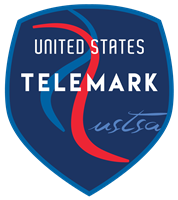Telemarking, and Its Local Star, is Pining for Olympics
Competitive alpine ski racers are generally done with the sport by their early 30s. But Jeannine Poucel didn’t even begin her racing career until reaching that age. She entered the very first race she saw in a snow discipline practiced by very, very few. Moreover, it was her first ski race of any kind. She recalls that spring of 2003 when, “I was skiing at Stevens Pass one day, and they were having a race, and I decided to sign up. And it went great! I came in second. I thought—this is it! I need to do this.”
This is telemark ski racing, the poorer cousin to alpine racing, and Poucel is one of the top-ranked athletes in the country. Now 37, she made the U.S. team last season. It’s an amateur team that has no affiliation with the much better known and funded alpine squad (see Libby Ludlow, p. 3). Yet the sport is actually older than alpine skiing. In the latter, your heel and toe are both fastened into the ski binding. In tele skiing, your heel flops loose like in a Nordic (cross-country) binding. Racers crouch gracefully into their turns—when executed correctly—on courses that are popular in Europe, especially in Norway.
Here in the U.S., tele skiing experienced a revival in the ’70s, but even with the advent of stiffer plastic boots (replacing leather), it remains a minority pursuit. Yes, you’ll see a few free-heelers at local ski areas—but racing? Who knew there was such a thing? Certainly not Poucel, who grew up playing soccer on Long Island (and later for Cornell), and had a very limited ski background before moving to the Northwest in 1997.
She was in grad school then and “really, really poor,” she says. “I worked in an outdoor/backpacker store, and they only had tele gear. I just started hiking and skiing, which is probably why I got better at teleing quickly. And I liked to ski fast on tele skis. Basically so I could keep up with people and [not] get left behind. Once I was out of graduate school and had a little bit more time, I bought a season pass [at Alpental].”
Soon after Poucel’s Stevens Pass debut, Crystal hosted the national championships, which she also entered, meeting competitors and organizers from the U.S. Telemark Ski Association. As she would soon learn, the USTSA had split from the parent organization (USSA) of the downhill, Nordic, and snowboarding teams back in the ’90s. This put a crimp in the tele revival, since fewer sponsors were willing to invest in an obscure sport that never made TV (except, again, in Norway).
But in obscurity lies opportunity, particularly for an all-purpose outdoor jock like Poucel. Says Tory Hauser, racer-turned-organizer at the USTSA, “If you’re a reasonably good athlete and you train hard, you can do very well.” Some, like Poucel, are late bloomers who come from the woolly mitten/backcountry side of the sport. Others are teenagers bored with snowboarding. Still others are former alpine racers like Bellevue’s Matt Macartney (brother of World Cup star Scott Macartney), who recently retired after several seasons on the telemark squad.
After an unsuccessful lobbying effort to get tele racing into the 1994 Olympics in Norway—ironically the birthplace of telemark skiing—the USTSA went its own way. Now the sport has a cart-before-the-horse problem: no TV, no sponsor funding; no public awareness, no TV. “The money is everywhere but in telemark,” says Hauser. While he insists the sport is growing rapidly—with something like 15 percent of lift ticket buyers on tele skis—the racing scene attracts only a minority within a minority. “You do it for love. It’s the ‘big fish in the small pond’ scenario.”
Which suits Poucel just fine. A West Seattle–based physical therapist, she incorporates telemarking into a year-round assortment of outdoor pursuits. In addition to a summer volleyball league and sailing, “I do a lot of lunges, a lot of stair running, weight lifting,” she say. “I unicycle. I bike up and down hills like crazy. And I surf—which I haven’t really convinced anybody is training. I went to Mount Hood this summer, just to get on snow. I’ll go to a park and set up a little obstacle course and sprint. I go stealth with it. No one knows what the hell I’m doing. My dog comes with me, and my fiancé.”
Come winter, the additional travel, training, and gear demands of tele racing elevate her to “high-end weekend warrior.” In recent years that’s required long, white-knuckle winter driving to competitions in Idaho, Colorado, Utah, and Montana, where she lived last winter and trained with the telemark team—as she expects to do again this year. “The plan right now is to buy a VW Vanagon so I can drive to all the other races.” (No such events are currently scheduled in Washington.)
Absent any prize money in the sport, Poucel estimates her expenses last winter approached $5,000. “It can get up there. It is financially restrictive. I do have to take off days during the week. Lost wages, sure. I am trying to get my own sponsors right now. I’m soliciting some local wineries and breweries in town here, a couple of sports shops. I’m trying now with Bank of America, and that would be huge. I think I’ll eventually hit up my family to sponsor me if I want to fly to Europe. The races this year are in Finland, Norway, the Czech Republic, Slovenia. I’ve never done a World Cup race before. If $10,000 dropped into my lap right now, I would book the trip.”
Yet Poucel doesn’t plan on retiring after her first year on the national team. Never mind that there won’t be any tele races at the 2010 Vancouver Olympics: “I know I’m totally pushing it if it’s 2014. But why not have that dream, really?”
bmiller@seattleweekly.com
FULL ARTICLE HERE: http://www.seattleweekly.com/2007-11-07/news/telemarking-and-its-local-star-is-pining-for-olympic-recognition.php
